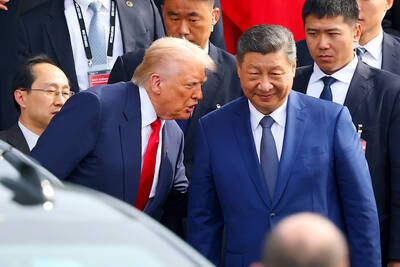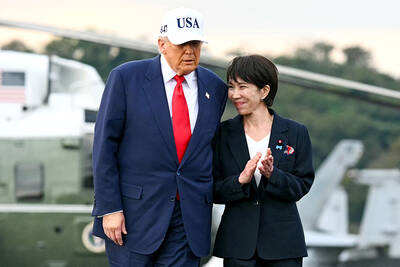A senior US intelligence analyst said on Thursday that China's military advantage over Taiwan continues to grow as China pumps money into improving its navy, air force and ground forces and boosts the number of advanced weapons facing its rival across the Taiwan Strait.
China's growing military capability also gives it a better chance to counter the US or another country that might intervene in the event of a war, Mark Cozad, a senior analyst with the Defense Intelligence Agency, told a Congressional advisory panel in a detailed assessment of China's military strength.
China raised its military budget by nearly 18 percent this year to about US$45 billion -- the biggest increase since 1995. The US Department of Defense says actual Chinese defense spending could be twice as high.
The Chinese navy and air force have been major beneficiaries of the increased money China has funneled into its military, Cozad told the US-China Economic and Security Review Commission.
China has bought or developed new diesel submarines, destroyers with long-range air defense systems and anti-ship cruise missiles; the air force has invested in advanced fighter aircraft and bombers, he said.
China's military modernization, Cozad said, focuses "on presenting a credible threat to Taiwan and preventing any third party that might intervene on Taiwan's behalf in a crisis."
Chinese officials say they are open about military spending and have increased military exchanges with other countries, including the US. Any outbreak of hostilities could ensnare the US, which is Taiwan's biggest arms supplier and is bound by law to help the nation defend itself.
Cozad said "the most telling sign of China's modernization and the balance of power in the Taiwan Strait" is the huge number of short-range ballistic missiles directly opposite Taiwan that is growing at an average rate of 100 missiles a year. US officials said last year that China had 800 missiles aimed at Taiwan.
Also at Thursday's hearing, Marine General James Cartwright, chief of the US Strategic Command, said China's Jan. 11 destruction of an old weather satellite using a warhead demonstrated its rapid improvement in military technology.
The test was widely criticized as a provocative display of China's growing military capability. Creating more opportunities for the two militaries to discuss their intentions would reduce the chance of future tension, he said.
also see story:
Joseph Wu urges China to be more open

UKRAINE, NVIDIA: The US leader said the subject of Russia’s war had come up ‘very strongly,’ while Jenson Huang was hoping that the conversation was good Chinese President Xi Jinping (習近平) and US President Donald Trump had differing takes following their meeting in Busan, South Korea, yesterday. Xi said that the two sides should complete follow-up work as soon as possible to deliver tangible results that would provide “peace of mind” to China, the US and the rest of the world, while Trump hailed the “great success” of the talks. The two discussed trade, including a deal to reduce tariffs slapped on China for its role in the fentanyl trade, as well as cooperation in ending the war in Ukraine, among other issues, but they did not mention

Japanese Prime Minister Sanae Takaichi yesterday lavished US President Donald Trump with praise and vows of a “golden age” of ties on his visit to Tokyo, before inking a deal with Washington aimed at securing critical minerals. Takaichi — Japan’s first female prime minister — pulled out all the stops for Trump in her opening test on the international stage and even announced that she would nominate him for a Nobel Peace Prize, the White House said. Trump has become increasingly focused on the Nobel since his return to power in January and claims to have ended several conflicts around the world,

REASSURANCE: The US said Taiwan’s interests would not be harmed during the talk and that it remains steadfast in its support for the nation, the foreign minister said US President Donald Trump on Friday said he would bring up Taiwan with Chinese President Xi Jinping (習近平) during a meeting on the sidelines of the APEC Summit in South Korea this week. “I will be talking about Taiwan [with Xi],” Trump told reporters before he departed for his trip to Asia, adding that he had “a lot of respect for Taiwan.” “We have a lot to talk about with President Xi, and he has a lot to talk about with us. I think we’ll have a good meeting,” Trump said. Taiwan has long been a contentious issue between the US and China.

Taiwan’s first African swine fever (ASF) case has been confirmed and would soon be reported to the World Organization for Animal Health (WOAH), Minister of Agriculture Chen Junne-jih (陳駿季) yesterday. The Ministry of Agriculture’s Veterinary Research Institute yesterday completed the analysis of samples collected on Tuesday from dead pigs at a hog farm in Taichung and found they were ASF-positive. Animal and Plant Health Inspection Agency Animal Quarantine Division chief Lin Nien-nung (林念農) said the result would be reported to the WOAH and Taiwan’s major trade partners would also be notified, adding that pork exports would be suspended. As of Friday, all samples